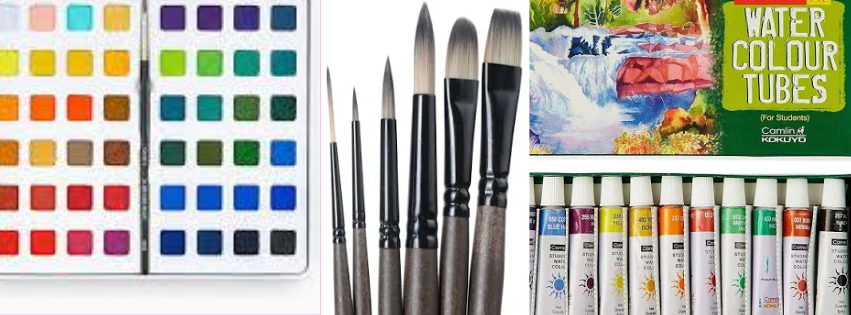
Materials required for water colour painting:
1. Watercolor Paper (Detailed)
Recommendations
• Student Grade: Canson XL Watercolor Paper (300 GSM) – Affordable and good for practice.
• Artist Grade: Arches Watercolor Paper (300 GSM, 100% cotton) – Professional quality, handles multiple layers.
• Specialty Papers: Strathmore Mixed Media Paper for experimenting with watercolors and other mediums.Tips for Choosing Paper:
• If you’re a beginner, start with cold-pressed paper (300 GSM) for its versatility.
• Use rough paper for landscapes or textured subjects.
• Always test a small piece to see how it reacts to your paint and techniques.2. Brushes (Detailed)
Recommendations by Type
• Round Brushes: Princeton Velvetouch Round Brush Set – Great for both beginners and professionals.
• Flat Brushes: Winsor & Newton Cotman Flat Brushes – Affordable and durable.
• Mop Brushes: Silver Brush Black Velvet Series – Ideal for large washes.
• Detail Brushes: Da Vinci Maestro Kolinsky Series for fine, detailed work.
• Fan Brushes: Escoda Fan Brush – Best for adding texture like grass or fur.Tips for Brushes:
• Invest in one or two high-quality natural brushes (like sable) for detailed work.
• Use synthetic brushes for general purposes—they’re affordable and easy to maintain.
• Wash brushes immediately after use to prevent damage.3. Paints (Detailed)
Student-Grade Recommendations
• Camlin Kokuyo Artist Watercolors (Pans): Affordable and vibrant for beginners.
• Winsor & Newton Cotman Watercolors (Tubes): Good quality and affordable.Professional-Grade Recommendations
• Daniel Smith Extra Fine Watercolors: Known for their exceptional pigment quality.
• Schmincke Horadam Watercolors: A premium option with brilliant colors and consistency.Essential Color Palette Suggestions
• Primary Colors: Alizarin Crimson, Ultramarine Blue, Lemon Yellow.
• Earth Tones: Burnt Sienna, Raw Umber, Yellow Ochre.
• Neutrals: Payne’s Gray, Sepia, White (gouache or titanium white for highlights).Tips for Paints:
• Start with a limited palette of 6-8 colors to learn mixing.
• Use artist-grade paints for more vibrant results and better lightfastness.
• Experiment with tube and pan paints to see what suits your workflow.4. Palette (Detailed)
Recommendations
• Plastic Palette: Mijello Airtight Watercolor Palette – Keeps paints fresh for long.
• Ceramic Palette: Jack Richeson Porcelain Palette – Perfect for easy cleanup.
• Metal Palette: Meeden Watercolor Tin with Pans – Compact and ideal for traveling.DIY Options:
• Use an old ceramic plate or a flat plastic tray as a makeshift palette.Tips for Palettes:
• Keep a dedicated mixing area separate from the wells holding your colors.
• Clean the palette regularly to avoid contamination.5. Water Containers (Detailed)
Recommendations
• Basic: Any sturdy plastic or glass containers work well.
• Professional Options: Collapsible silicone water cups (like Faber-Castell’s).Tips:
• Use two containers: one for clean water, the other for rinsing brushes.
• Change the water frequently to avoid muddying your colors.6. Masking Tools (Detailed)
Recommendations
• Masking Fluid: Pebeo Drawing Gum – Reliable for preserving white areas.
• Masking Tape: Scotch Artist Tape – Doesn’t tear paper upon removal.Tips for Use:
• Use a cheap brush or apply masking fluid with a silicone tool to avoid damaging your good brushes.
• Allow masking fluid to dry completely before painting over it.7. Accessories for Texture and Detailing (Detailed)
Sponges:
• Use natural sea sponges for creating organic textures like clouds or foliage.
• Synthetic sponges work well for controlled effects.Salt:
• Table salt or coarse sea salt absorbs pigment to create starburst textures.Plastic Wrap:
• Lay plastic wrap over wet paint and press lightly to create abstract, crackled patterns.Toothbrush:
• Dip a toothbrush in paint and flick it with your thumb for splatter effects like stars or snow.8. Storage and Workspace Essentials (Detailed)
Recommendations
• Brush Holders: Roll-up canvas brush holders or plastic cases.
• Paint Organizer: Stackable containers or drawers for tubes/pans.
• Drawing Board: Lightweight MDF boards for securing your paper.Tips:
• Use a tilted surface (slightly angled board) for better control over washes.
• Store brushes horizontally or upright with bristles facing upward.9. Additional Tools (Detailed)
Pencil and Eraser:
• Pencil: Faber-Castell Graphite Pencils (HB or 2B for sketching).
• Eraser: Kneaded eraser for soft corrections without damaging the paper.Ruler:
• A transparent ruler works well for precision and layout.Hairdryer:
• Speeds up drying time and helps fix layers for glazing techniques.Spray Bottle:
• Use a small misting spray bottle to keep your paints wet or create water effects on paper.10. Varnish and Preservation (Detailed)
Fixative Spray:
• Winsor & Newton Fixative Spray – Protects finished works from smudging or environmental damage.Portfolio Case:
• Store finished artwork in acid-free folders or a dedicated portfolio case.This guide covers everything you need to get started or improve your watercolor painting setup. Let me know .
